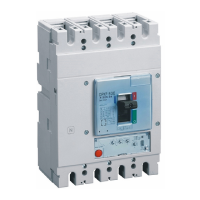
Do you have a question about the LEGRAND DPX3 630 and is the answer not in the manual?
| Rated current In | 630 A |
|---|---|
| Poles description | 3P, 4P |
| Breaking capacity Icu | 50 kA |
| Frequency | 50/60 Hz |
| Standards | IEC 60947-2 |
| Rated ultimate short-circuit breaking capacity | 50 kA |
| Breaking capacity Ics | 37.5 kA |
| Rated service short-circuit breaking capacity | 37.5 kA |
| Protection degree | IP20 |
Front view with dimensions for 3P and 4P stationary versions.
Details on standard flat screw terminals and insulating barriers.
Describes vertical, horizontal, and power switching mounting positions.
Detailed technical specifications for DPX3 circuit breakers and DPX3-I disconnectors.
Diagram identifying key components of the circuit breaker.
Breaking capacity, rated current, power loss, and operating conditions.
Derating for temperature, altitude, 400Hz, and DC networks.
Explanation of symbols and designations used in the document.
Details on residual current protection and types of releases.
Specifications for auxiliary and alarm contacts.
Information on rotary and motor drives for switch operation.
Terminal shrouds, crimp blocks, and busbar extensions.
Base and mechanism for converting to slide-out version.
Key locks for securing the sliding mechanism.
Accessories for the sliding mechanism, including handles and contacts.
Time-current curves for thermal-magnetic trip units up to 800A.
Time-current curves for thermal-magnetic trip units from 1000-1250A.
Graph showing I²t energy limitation for different current ranges.
Graph showing limited current (Ip) vs. short-circuit current (Icc).
Schematic diagram for the automatic control unit.
Guide to setting parameters for the automatic control unit.
Explanation of automatic and manual modes and selector operation.
Step-by-step guide for performing manual operations.
Diagram illustrating the process of closing the switch.
Diagram illustrating the process of opening the switch.
Diagram illustrating the reset procedure after a trip event.
Instructions for removing covers and drilling diaphragms.
Procedure for applying the nameplate.
Details on installing voltage/shunt releases and switch covers.
Instructions for positioning the lever by loading the spring.
Steps for mounting the motor base and tightening the shield.
Using the lever to position the protective shield.
Procedure for installing a padlock for switch locking.
Procedure for installing a key lock and removing the motor cover.
Diagrams and component list for keylock assembly.
Step-by-step guide for installing the keylock mechanism.
Explanation of AC, BD, F, E contacts and their behavior in different modes.
Diagrams showing operations with push buttons, with/without shunt release.
Diagrams showing operations with switches, with/without shunt release.
Schematic diagram for the automatic control unit.
Guide to setting parameters for the automatic control unit.
Requirements for switching time between main and emergency power lines.
Details on motor usage modes and operation sequences with voltage.
General safety guidelines for installation and use of the product.
